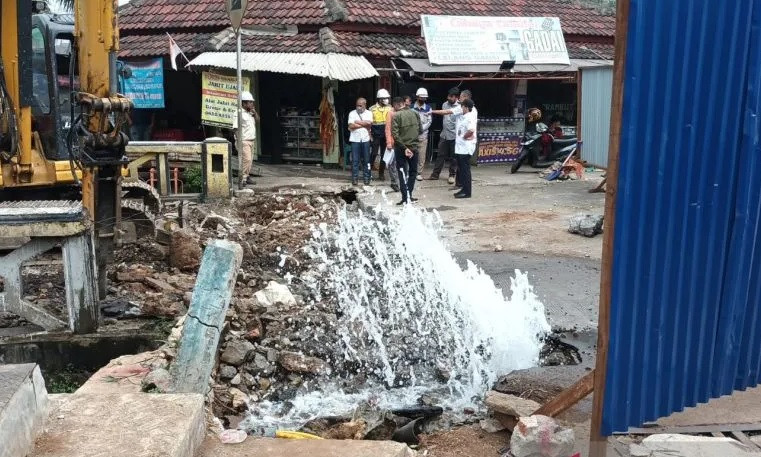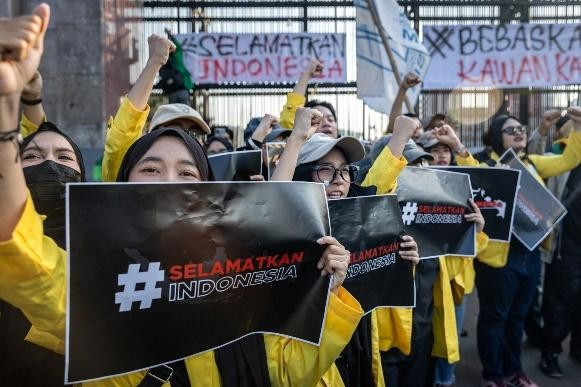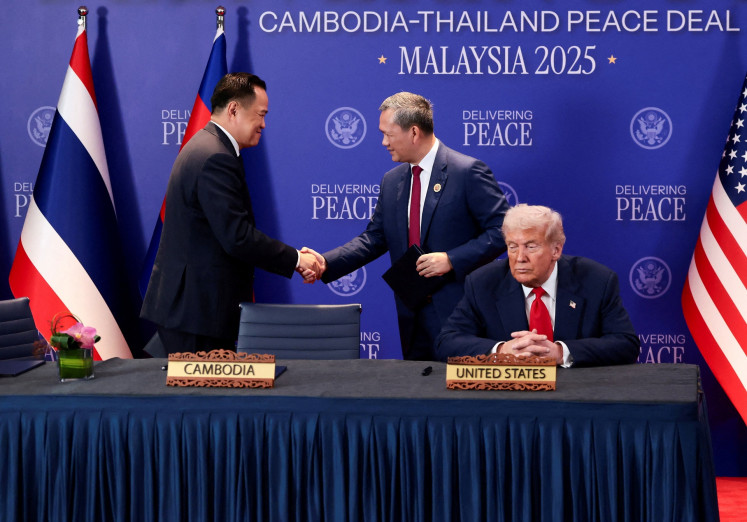Popular Reads
Top Results
Can't find what you're looking for?
View all search resultsPopular Reads
Top Results
Can't find what you're looking for?
View all search resultsHow Asian governments can reduce physical and commercial water losses
Prolonged substandard water infrastructure can cause intermittent to no water supply or cause contaminated groundwater to enter distribution pipes during supply interruptions and high-pressure periods.
Change text size
Gift Premium Articles
to Anyone
T
he loss of water in public infrastructure can create financial and social challenges for any government in the world. This critical issue requires a solution, and governments can learn from a promising approach that Infrastructure Asia and the World Bank Group have identified through our experiences with local governments in Indonesia.
Before it reaches citizens, some level of potable water is lost in public infrastructure through pipe leakages, theft, and unbilled water. This water that is lost and unaccounted for is known as non-revenue water (NRW).
If left unmitigated, NRW can accumulate significant financial losses. On a global scale, 346 million cubic meters of drinking water – the equivalent of 140,000 Olympic-sized swimming pools – is lost daily through NRW. This adds up to a cost of US$39 billion per year. In Indonesia, which has a 2019 NRW rate of 32 percent, this can contribute to economic losses of around $579 million per year.
At the national level, high NRW also disrupts the financing of local infrastructure development. Utility authorities will find it difficult to maintain water tariff affordability and enact effective water production cost recovery. This limits the surplus needed to rehabilitate ageing water infrastructure – which in itself causes high NRW – and also slows down improvements to tariff collection systems and operational efficiencies.
High NRW can also impact a population’s social well-being by undermining the provision of undisrupted potable water access. Prolonged substandard water infrastructure can cause intermittent to no water supply or cause contaminated groundwater to enter distribution pipes during supply interruptions and high-pressure periods. With increasing water scarcity brought about by global warming, this social impact cannot be overlooked.
Inaction on reducing NRW will only compound to higher costs, and it is imperative that governments prioritize sustainable long-term NRW reduction plans. Through Infrastructure Asia and the World Bank Group’s regular capacity-building programs and identification of suitable financing and technology solutions to address regional NRW, we have identified a promising three-enabler approach that governments can adopt to guide their NRW Programs.
Firstly, top-level management support is crucial to set clear strategic targets and advocate NRW reduction programs to all stakeholders. NRW reduction is a long-term commitment, and a combined effort from stakeholders at different levels is needed.
Utility authorities should then establish a dedicated and permanent team to develop future ready NRW reduction roadmaps. This team will sustain progress by prioritizing implementation efforts and deploying suitable investments. To ensure the program reaps maximum benefits, this team should be entrusted to monitor success and appropriately adjust investments where necessary.
Given these responsibilities, the program needs a team that has the capabilities to oversee the entire water infrastructure lifecycle. Utility authorities should aim to build capacity in the areas of law, regulatory frameworks, project planning, technology and technical capabilities. Regular collaboration and investment co-sharing across public utilities will also be beneficial in building these capabilities.
Securing the right resources
Selecting the right mechanisms to resource this strategy can also strengthen NRW reduction outcomes and program management. Utility authorities should make informed decisions on financing tools based on project requirements, public-private partnerships and risks. Facilitators like Infrastructure Asia can intervene by bringing together experts from relevant domains to help bridge financing gaps.
Developmental financing is a useful foundational tool to consider. Development finance institutions (DFIs) such as the World Bank Group and the Asian Development Bank could provide helpful mechanisms such as equity participation, guarantees and technical assistance to fund NRW reduction programs with high risk.
To further plug the financing gaps, utility authorities with strong public-private partnerships can explore private sector financing to form a blended finance model. By tapping on high liquid international private capital such as the Climate Invest Two (CI2) fund, utility authorities can appropriately fund activities along the water infrastructure value chain.
Another mechanism is performance-based contracting (PBC), which incentivizes private companies to deliver NRW outcomes more efficiently and innovatively by granting contractors more flexibility in implementing solutions. Through this option, contractors are reimbursed based on their NRW program performance. This option was utilized successfully in Ho Chi Minh City’s NRW reduction efforts, with the city saving an impressive 122 million liters of water daily.
Embracing best fit technologies
Utility authorities can also explore applying technologies such as artificial intelligence (AI) or machine learning to water production and distribution. Utility authorities should evaluate current processes and identify digitalization opportunities, as doing so can improve NRW program outcomes such as operational efficiency, monitoring accuracy and cost management.
There are many exciting potential applications. For example, digital control systems and AI can improve the productivity of monitoring teams by identifying big leakage points and prioritizing pipe rehabilitation efforts. Commercial losses can also be reduced by using digital water meters and online data monitoring services to monitor meter performance and functionality more closely. Finally, sensors could be used to improve pressure management by modulating water supply and ensuring maximum asset lifetimes.
The success of Malang
To demonstrate the strength of this approach, utility authorities can learn from the success of Indonesia’s Malang City. In exemplifying the three-enabler approach, the East Javan city was able to reduce NRW by 30 percent. This amounted to savings of more than 70 million cubic meters of water and about $24 million in revenue in 10 years, which also greatly improved citizens’ access to potable water.
Malang city’s utility authorities, known as PDAM Tugu Tirta, first received strong management support to formulate a 10-year plan and roadmap. Impressively, the PDAM secured more than Rp 5 billion ($4 million) to begin the transformation of the city’s water infrastructure and facilities.
A well-resourced team with relevant capabilities was also built. With strong experience in deploying infrastructure digital solutions, they worked closely with private sector partners to set up virtual Distributed Meter Areas (DMA) in critical areas. This allowed them to digitalize their assets, which enabled real-time monitoring of water leakages to prioritize leak repair efforts with minimal manpower.
Following its initial success, the PDAM Tugu Tirta further optimized its operational efficiency by setting up a 24/7 command center and deploying sensor technologies to better manage water pressure management and detect active leaks. On top of contributing to a lower NRW rate, these digital capabilities enabled the PDAM to decrease overall commercial losses by speeding up water leakage fixes to just one day.
Coming together
For many developing societies, water is a crucial resource that needs to reach all segments of society safely and sustainably. Ideally, it should also deliver optimum results for a country’s economy and infrastructure. Reducing NRW is key to these outcomes.
Moving forward, it is important that utility authorities around the world share knowledge to address NRW and similar challenges. Malang City’s success has shown that there are many valuable lessons to be shared with other Asian cities, who can adapt them to solve similar local issues. To galvanize this spirit of regional collaboration, Infrastructure Asia and the World Bank Group will be working closely together with more cities to scale similar non-revenue water successes in the region.
It is our hope that with the right strategies, resources and technologies, utility authorities around the world can work together and begin addressing the urgent issue of NRW in their own capacity today.
***
The writer is executive director at Infrastructure Asia. This article was adapted from a report coauthored by Infrastructure Asia and the World Bank Group. Read the detailed report here.











